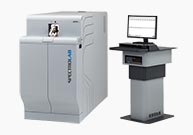

The chapter also lists several examples of metalwork, most of them on coinage, and important non-ferrous metals and alloys used in the past. Some complement radiation techniques are also considered. The main properties and differences for the most useful techniques are given in the chapter. The aim of this work is to give a general description on the usage of radiation techniques for determining the provenance of metals and understanding the manufacture technology of metallic objects. This chapter focuses on the study of the characterization and provenance of coins and other metal work using XRF, PIXE and activation analysis. At last, a third example shows the significant socio-economical assumptions developed by determining the characteristic trace elements of gold when coinages are considered. Two applications illustrate both the potential of examination techniques to identify the authenticity of gold jewellery and the importance of combining examination techniques and elemental analysis to describe the fabrication stages of goldwork. The aim of this article is to give a short overview of the use of the most established scientific-based techniques in the study of goldwork, with special outlining on the limitations, advantages and applications of x-ray based techniques. Through the examination of the objects by x-ray radiography and the non-destructive elemental analysis of the gold alloys – by XRF, SEM-EDX, PIXE and SR-XRF, x-ray based techniques have always played an important role in the study of cultural heritage and, in particular, of goldwork. NuFrom the study of coins and casted simple objects to intricate jewellery comprising many diverse parts joined together, analytical queries on ancient goldwork concern the description of the manufacturing techniques, the identification of the authenticity and the localisation of the exploited sources of gold.

fire-gilding, and another type without remnants of mercury, presumably diffusion bonding. Additionally, two types of gilding were revealed by the XRF analysis, one with remnants of mercury, i.e. The composite objects were assembled using three methods: (i) mechanical attachment (ii) low-temperature, lead-tin soft solders or (iii) high-temperature, copper-silver hard solders. The ewers were constructed in two ways: (i) the base and the body weremade separately, or (ii) the ewer was raised from a single silver sheet. The chemical composition as well as the Bi/Pb ratio suggests that the parts of the composite objects were manufactured from different silver ingots. The gold and lead content of the objects shows constant values (less than 1 wt%Au and Pb). Copper was added intentionally to improve the mechanical properties of soft silver. The results demonstrate that all the objects were made from high-quality silver (above 90 wt% Ag), with the exception of the base of the Geometric Ewer B. The measurements were systematically performed along a pre-designed grid at several points using handheld X-ray fluorescence analysis. The Seuso Treasure consists of fourteen large silver vessels that were made in the fourth–early fifth centuries AD and used for dining during festive banquets and for washing and beautification. This study details the non-destructive chemical analysis of composite silver objects (ewers, situlas, amphora and casket) from one of the most significant late Roman finds, the Seuso Treasure.


 0 kommentar(er)
0 kommentar(er)
